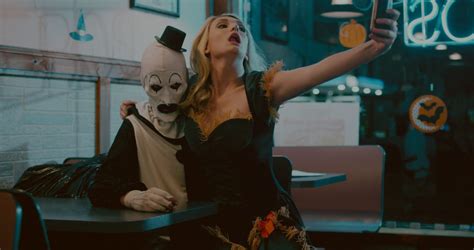Terrifier Nude

The 2016 horror film, Terrifier, directed by Damien Leone, has gained quite a reputation for its graphic violence and disturbing imagery. One particular scene that has sparked curiosity and controversy involves the character Victoria, portrayed by Jenna Kanell, appearing in a state of nudity. This article aims to delve into the context, impact, and implications of this scene within the film's narrative, providing a comprehensive analysis for enthusiasts and critics alike.
The Controversial Scene: Victoria's Vulnerability

In Terrifier, Victoria, a young woman attending a Halloween party, becomes the target of the film's primary antagonist, Art the Clown. As the night unfolds, Victoria finds herself in a terrifying predicament, facing Art's relentless pursuit. It is during this intense sequence that Victoria, in a desperate attempt to escape, sheds her clothes, adding a layer of vulnerability and intensity to the scene.
The scene in question is not merely gratuitous; it serves a narrative purpose. It highlights Victoria's state of desperation and her willingness to do whatever it takes to survive. Her nudity becomes a symbol of her raw, unguarded state, stripped of any defenses against the relentless Art. This moment adds a psychological depth to the film, exploring the themes of power dynamics and the primal instincts that arise in life-threatening situations.
Contextualizing the Nudity
While nudity in horror films is not unprecedented, the context in which it is presented in Terrifier sets it apart. Unlike many films that utilize nudity as a shock factor or a means to titillate, Leone's direction ensures that the scene maintains a disturbing and unsettling tone. The focus remains on Victoria's emotional and physical turmoil, with the nudity serving as a powerful tool to accentuate her fear and vulnerability.
Furthermore, the film's aesthetic choices enhance the impact of this scene. The lighting and camera angles create an atmosphere that is both intimate and distressing, drawing the audience into Victoria's harrowing experience. The combination of these elements ensures that the scene is not merely a gratuitous display but a carefully crafted moment that contributes to the overall narrative and thematic depth of the film.
| Film | Year | Director |
|---|---|---|
| Terrifier | 2016 | Damien Leone |

Exploring the Psychological Impact

The nudity scene in Terrifier goes beyond the visual aspect, delving into the psychological realm. It evokes a range of emotions and reactions from viewers, often sparking intense discussions about the role of horror in cinema and the boundaries of artistic expression.
From a psychological perspective, the scene can be interpreted as a representation of the raw, primal state that humans revert to when faced with extreme danger. It taps into our deepest fears and primal instincts, leaving a lasting impression on viewers. The raw emotion and vulnerability displayed by Victoria resonate with audiences, creating a powerful and memorable cinematic experience.
Art the Clown: A Master of Psychological Terror
Art the Clown, the film's antagonist, is a master manipulator, exploiting his victims' fears and insecurities. In the context of Victoria's nudity, Art's presence takes on a new dimension. He becomes a symbol of the audience's collective fear, preying on Victoria's vulnerabilities and exploiting her state of undress to exert his power. This psychological manipulation adds a layer of complexity to the character, making him a truly terrifying force.
The scene's impact is further enhanced by the film's attention to detail in terms of character development. Victoria's journey, from a confident partygoer to a vulnerable and terrified individual, is meticulously crafted. This transformation, marked by her nudity, becomes a pivotal moment in the film's narrative, shaping the audience's perception of both Victoria and Art.
Critic and Audience Reception
The scene featuring Victoria's nudity in Terrifier has generated a mixed response from critics and audiences alike. While some praise the scene for its boldness and contribution to the film's overall tone and narrative, others have expressed discomfort and criticism.
Critics who appreciate the scene highlight its effectiveness in conveying the raw, unfiltered emotions of the character. They argue that it adds a layer of realism and intensity to the film, pushing the boundaries of traditional horror storytelling. These critics often commend the film's ability to provoke strong reactions and engage viewers in a deeper exploration of fear and vulnerability.
On the other hand, critics who express discomfort with the scene often question its necessity and the potential objectification of the female character. They argue that while the scene may have artistic merit, it could be interpreted as gratuitous or exploitative, detracting from the film's overall message and impact. These critics emphasize the importance of sensitivity and respect when depicting vulnerable characters in such intense situations.
Audience Perspectives
Audiences, too, have varying reactions to the scene. Some viewers report feeling deeply disturbed and impacted by the intensity and emotional depth conveyed through Victoria's vulnerability. They appreciate the scene's contribution to the film's overall atmosphere and the way it heightens the sense of fear and desperation. These viewers often praise the film for its willingness to push boundaries and challenge expectations.
Conversely, other audience members express discomfort and even disgust with the scene. They find it gratuitous and unnecessary, feeling that it crosses a line in terms of taste and decency. These viewers often question the scene's purpose and suggest that it may detract from the film's overall quality and message. Their reactions highlight the fine line between artistic expression and potential exploitation, sparking ongoing debates within the horror community.
| Critic/Audience Perspective | Reaction |
|---|---|
| Praising Critics | Appreciate the scene's boldness and emotional impact, enhancing the film's tone and narrative. |
| Critical Critics | Express discomfort, questioning the necessity and potential objectification of the scene. |
| Supportive Audiences | Feel deeply impacted by the scene's intensity and emotional depth, praising its contribution to the film's atmosphere. |
| Discomforted Audiences | Experience discomfort or disgust, finding the scene gratuitous and detracting from the film's quality. |
The Artistic Intent and Future Implications
The inclusion of the nudity scene in Terrifier can be interpreted as a deliberate artistic choice by the filmmakers. It reflects their vision to push the boundaries of horror cinema and explore the darker aspects of human nature. By presenting a vulnerable character in such an intense situation, the film invites audiences to confront their own fears and consider the complex dynamics of power and vulnerability.
Looking ahead, the impact of this scene on the horror genre and its future implications are worth exploring. It has the potential to spark important conversations about the representation of vulnerable characters in horror films and the fine line between artistic expression and exploitation. As horror continues to evolve, filmmakers may be inspired to explore similar themes, challenging audiences and pushing the boundaries of what is considered acceptable in cinematic storytelling.
A Call for Responsible Storytelling
While Terrifier's nudity scene has generated a range of reactions, it serves as a reminder of the responsibility that comes with creating disturbing and intense content. Filmmakers must carefully consider the impact of their choices and ensure that vulnerable characters are portrayed with respect and sensitivity. By doing so, they can maintain the integrity of their art while engaging audiences in meaningful and thought-provoking experiences.
In conclusion, the nudity scene in Terrifier is a powerful and controversial element of the film's narrative. It adds depth and intensity to the story, exploring themes of vulnerability and fear. While it has sparked varying reactions, it serves as a reminder of the impact that horror cinema can have and the importance of responsible storytelling in pushing the boundaries of artistic expression.
What inspired the creation of Art the Clown as a horror character?
+
Damien Leone, the director of Terrifier, drew inspiration from his childhood experiences with clowns. He aimed to create a character that evoked a sense of childhood fear and unease, tapping into the collective subconscious where clowns can represent both joy and terror.
How did the production team handle the sensitive subject matter of the nudity scene?
+
The production team approached the scene with respect and sensitivity. They ensured open communication with the actress, Jenna Kanell, to make her feel comfortable and empowered during the filming process. The scene was carefully choreographed and shot to maintain a level of dignity and artistic merit.
What impact did Terrifier have on the horror film industry, particularly in terms of pushing boundaries?
+
Terrifier’s bold approach to horror, including the controversial nudity scene, sparked discussions about the boundaries of artistic expression in the genre. It encouraged filmmakers to explore more intense and provocative themes, pushing the limits of what horror cinema can achieve.



